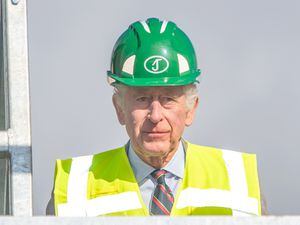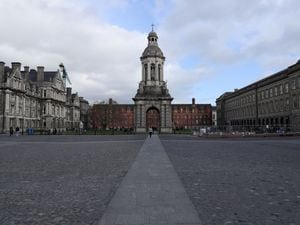King thanks workers at sawmill that deals with timber from Balmoral
Charles made his second visit to the sawmill in Aberdeenshire.

The King has thanked workers at a sawmill in Aberdeenshire that has bought thousands of tonnes of timber from a royal estate.
Charles made his second visit to the James Jones and Sons Limited sawmill at Aboyne, which has bought timber from the Balmoral Estate for more than 34 years but said he does not know whether he will “be around” for a further visit in another 24 years’ time.
The sawmill opened in 1962 and primarily serves the Scottish market, but also exports to Australia and New Zealand.
It was rebuilt in 1991, and Charles visited eight years later when he was Prince of Wales, which some workers remembered.

The King thanked “marvellous” workers for processing timber from Balmoral and asked about the price of it.
Company chairman Tom Bruce-Jones, whose father welcomed Charles in 1999, joked it was “too expensive”.
Charles said: “Well done everybody thank you very much for all the efforts you made.
“Thank you for dealing with some of the Balmoral timber.”
“Whether I will be able to come back in another 24 years, I don’t know if I will be around.
“I hadn’t realised what an area you cover around the world, it depends on all the marvellous people who put so much into it.”
The sawmill has bought about 150,000 tonnes of timber from the Balmoral Estate over more than three decades.
Charles wore a hard hat and hi-vis for most of the visit, which is believed to be the first time he has done so since becoming King.

The sawmill now trades indirectly with the Balmoral Estate, including high-quality pine, but the working relationship goes back decades.
It recently had a £15 million investment to increase sustainability and produces construction timber, which can be used as a substitute for steel and concrete.
It can transform one large log into 24 smaller pieces in a single pass with the production process using 100% of the log, with sawn timber going to market, while chips and sawdust go for chipboard and bark to horticulture.
Any remaining residues are used to fire the biomass boiler to heat kilns for timber drying.
The King was introduced to the site manager, primary processing manager and saw-line operator at the five-generation firm.
He also unveiled a plaque commemorating the visit, which was made on-site, and signed the visitor book.

Apprentice Kieron Cassie, 21, said: “I think a fair few folk have been feeling excited.
“He asked me a couple of questions. The plaque was made here.”
Saw doctor Robert Booth, 62, has worked there 46 years, and remembered Charles’ visit in 1999, when he caught workers out who were taking an early lunch break.
Mr Booth said: “I was sitting on my bum and Prince Charles walked in.
“We were told to keep working, we didn’t think he would come in. It was like a privilege.
“He spoke about the environment and he seemed pretty concerned about it.
“He asked how long the saws last and what happens to them.”

Angus Milligan, 48, said: “It’s a great honour, we appreciate the fact the Royals spend time here. People come and spend money hoping to see the royals.
“He comes up here and is able to be himself, it’s an escape.”
Mr Bruce-Jones said: “We were honoured to welcome His Majesty to our Aboyne site to demonstrate the extent of investments and technology upgrades.
“We discussed the significant benefits of productive forestry acting as carbon sinks and the merits of continuing to meet and exceed annual planting targets across the UK.
“We were able to showcase the environmental advantages of UK-grown structural timber products to support our collective views on building future houses sustainably.”





